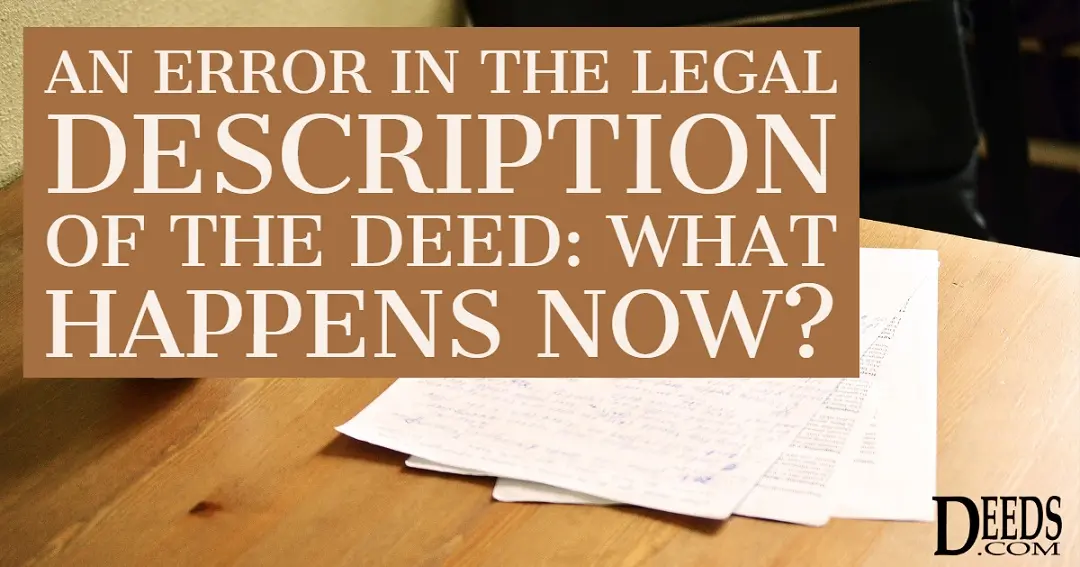
What can the buyer do when a real estate deed carries an incorrect legal description of the property? Perhaps it describes the wrong parcel, or fails to reflect all land purchased in the sale.
An error in a legal description of a property has consequences. It can affect taxes. As lenders extend loans based on a percentage of the property’s appraised value, footage mistakes can sink a loan approval. If the error is neglected, disputes can arise later, and they can become the stuff of nightmares.
Worst-Case Scenarios
Some deeds bear legal descriptions drafted using early survey methods, pre-dating GPS measurements. Some have errors in lot descriptions that get passed unwittingly from one owner to the next—a sort of legal time bomb waiting to take someone by surprise.
In one case, a veteran spent many years’ worth of savings to buy a single-family home, and later decided to survey the property in order to get fence lines drawn. This unearthed a serious error in the title. The legal description in the deed represented the wrong lot—not the parcel on which the house stood. When the vet tried to swap land with the neighbors to correct the issue, the neighbors resolved to evict the vet’s family and take the home.
The vet’s case is severe. Yet cases like it are not unusual. Survey requirements and recording laws suffered neglect the real estate bubble frenzy from 2004 to 2006. Inaccurate deeds have wreaked havoc in county recording offices ever since.
Two Ways to Update a Legal Description in the Deed
When a mistake in the legal description comes to light, the remedies depend on the nature of the error. Is it a scrivener’s error? Or is it a substantive issue?
Resolving Small Ambiguities: The Scrivener Affidavit
Sometimes an omission attracts attention just after recording. It’s minor, and everyone knows what the description meant to say. A clarification would help, and would not materially change the deed. It would simply tighten up ambiguous language in the legal description.
In this case, state law typically offers a straightforward and simple remedy. The attorney responsible for preparing the deed signs an affidavit stating that the property was intended to be described as in the affidavit. This is commonly called a Scrivener Affidavit.
Where permitted by law, the already-recorded deed does not need replacement with a new deed. It can instead be accompanied by a Scrivener Affidavit. State law lays out the specific and strictly limited types of issues a Scrivener Affidavit may remedy.
The county recorder of deeds maintains the local rules outlining everything that must be in place when submitting the Scrivener Affidavit. The affidavit must comply with local and state standards for recorded documents.
The state requirements may include:
- A cover letter that states its reason, drafted by the person who prepared the previously recorded deed.
- The attachment of the affidavit to the originally recorded deed. The affidavit refers to the provision of state law that permits it, and contains the clarifying information, certified by the person submitting it under penalty of perjury.
- Notification to the original parties or the parties’ heirs.
To update the public records, the completed affidavit, along with any necessary supporting materials, must go to the county recorder of deeds.
The Correction Deed: Stronger Than a Scrivener’s Affidavit
Material changes to the description of the property cannot be corrected by appending an affidavit and cover sheet.
So, for example, the wrong lot, as in the unlucky veteran’s case, or a description that states the wrong compass direction and thus changes the boundaries of the property, cannot be rectified with an Affidavit of Correction. The deed has to be replaced with a correction deed.
A correction deed includes the information recorded on the previously recorded (erroneous) deed. It notes the mistake, and the accurate legal description. Parties may not bring new names onto the deed, create any other new interests, or modify the substance of the deed.
With material errors, both parties need to be aware of the corrective action, and both must agree to the correction. Otherwise, a court order may be the only recourse. Through a deed reformation action, a court may order the clerk of the court to correct (reform) a deed and resolve the problem.
The Steps to Create and Record a Correction Deed
To create and record a correction deed, the preparer should obtain a copy of the current deed, and take the following steps:
Step 1. Obtain your correction deed form.
Download the correct form, depending on the state in which the property is located and that state’s requirements for correction deeds.
Step 2. Execute the correction deed.
Usually, the seller must execute a correction deed, in accordance with state notary and witness requirements.
Step 3. Record the correction deed.
You may be able to re-record the same document with corrections. You might need a new correction deed. Not only does state law vary; in many states, such as Pennsylvania, county laws vary, too. Whether you record or re-record, new recording fees apply.
Every Detail Matters
Correction deeds must be completed with precision. At Deeds.com, we meticulously provide you with reliable forms. Our formats comply with every detail of each jurisdiction’s rules, and include supplemental forms a state or county recorder requires. We continually update our documents in compliance with current law.
Supporting Research:
https://shuffieldlowman.com/a-defective-deed-now-what/
https://www.stimmel-law.com/en/articles/basics-real-estate-title-deeds
